
1923
Oct. 27 Roy Fox Lichtenstein is born in Manhattan to Milton (1893–1946) and Beatrice (Werner Bernardi; 1896–1991). Milton, a real-estate broker for Lichtenstein & Loeb and co-owner of Garage Realty, is a first-generation German Jewish American. Beatrice, a homemaker and gifted piano player, is of German Jewish descent. The family resides on the Upper West Side in New York at 240 West 98th Street.
1924
Family moves to 310 West 99th Street.
1927
Family resides at 924 West End Avenue at 105th Street.
Dec. 17 Sister Renée is born.
1928
Fall Attends kindergarten near 104th Street and West End Avenue.
1931
Over concerns about the Depression, family moves to a smaller apartment at 505 West End Avenue at 84th Street.
Fall Begins first grade at P.S. 9. Develops a strong interest in drawing and science and later recalls spending time designing model airplanes. Frequently visits the American Museum of Natural History. Favorite radio shows include The Shadow, Jack Armstrong, Flash Gordon and Mandrake the Magician.
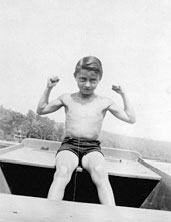
Lichtenstein, age eleven, at Lake Buel, in Massachusetts, 1933. Photographer unknown.
The Roy Lichtenstein Foundation Archives.
1934
Family moves to a much larger seven-room apartment at 305 West 86th Street with his maternal grandfather. Father’s business is unaffected by the Depression.
1935
Oct. 10 George Gershwin’s Porgy and Bess debuts at the Alvin Theater. Later makes pen-and-ink sketches of the show.
1936
Fall Starts eighth grade at Franklin School for Boys, a private school in Manhattan. Interest in art is piqued because Franklin offers no such instruction. During high school, studies French and Latin.
1937
Enrolls in Saturday morning watercolor classes at the New York School of Fine and Applied Art (now Parsons School of Design). Paints still lifes and flower arrangements using watercolor and opaque watercolor; also works directly from the model.
During high school, studies the clarinet and plays the piano. With friend Don Wolf, visits jazz clubs. Forms a small band.
Summer Makes “romantic watercolors” of the forest trees and lake while at camp in Maine.
Receives first art book, Thomas Craven’s Modern Art: The Men, the Movements, the Meaning (Simon and Schuster, 1934).
1938
Jan. 16 Attends Benny Goodman’s first concert at Carnegie Hall. Begins doing renditions of jazz musicians.
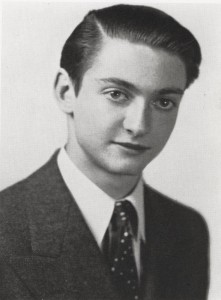
High School Portrait, Franklin School for Boys, New York, ca. 1940.
The Roy Lichtenstein Foundation Archives
1939
Apr. 30 Opening of the 1939–40 World’s Fair in Flushing Meadows, New York, whose theme is “Building the World of Tomorrow.” Is a frequent visitor.
1940
June Graduates from Franklin.
July 1–Aug. 9 Attends Reginald Marsh’s painting class at the Art Students League. Learns to paint directly from the model. Studies anatomical drawing and Renaissance techniques such as glazing and underpainting, which he is encouraged to apply to quotidian subjects. Later recalls Marsh adding musculature and the like to his paintings. Feeling that Marsh’s paintings have a “very brassy, commercial quality,” is ultimately dissatisfied with the course’s insistence on technique over process. In most paintings from the time, strives for exact representation of model.
Sept. 23 Begins undergraduate degree at the Ohio State University (OSU) in the College of Education. First art classes are Art Appreciation, taught by Frank Roos, and Advanced Freehand Drawing. Other classes include Education Survey, Field Artillery and Botany. Pledges Phi Sigma Delta and moves into the fraternity house at 1968 Iuka Avenue in Columbus.
Nov. 7–Dec. 8 Sees Picasso’s masterwork Guernica (1937; Museo Nacional Centro de Arte Reina Sofía, Madrid) at the Cleveland Museum of Art, which is a venue for Picasso: His Forty Years of Art, organized by the Museum of Modern Art, New York (MoMA).
Paintings of the period include abstract works based on landscapes, still lifes and figure studies.
1941
Winter Classes include Elementary Design and Elementary Freehand Drawing, along with Field Artillery and Comprehension and Reading.
Spring Takes Drawing from the Head, taught by Robert Gattrell, and Introduction to Literature, as well as continued classes in field artillery.
Fall Enrolls in History through the Ages, taught by Robert Fanning, a yearlong survey course of Western, Asian and Indian art history. Textbook is Art through the Ages (Harcourt, Brace, 1926) by Helen Gardner. Takes first drawing class taught by Hoyt Sherman, Drawing from Life. Learns about the concept of kinesthetic drawing, which is based on psychological optics. In 1945, Sherman realizes his “flash lab,” a totally darkened room in which a tachistoscope projects slides of objects in quick succession. Students draw what they see based on the automatic recall of afterimages formed on their retinas. Does not experience Sherman’s flash lab, but his idea of art—reflected in statements such as “Organized perception is what art is all about”—is deeply influenced by Sherman.
Moves to North High Street off campus in Columbus.
Picasso’s Blue Period is a significant influence despite pervasiveness of Regionalism at OSU.
1942
Winter Attends Intermediate Design with Roos, and Sculpture with Erwin Frey, where he works with Plasticine. Later recalls making a blue ceramic water buffalo sculpture. Other classes include Mechanical Drawing, economics, humanities and the natural sciences.
Moves to student housing; creates oil painting of roommate’s feet soaking in a basin. Among works admired at the time are Pablo Picasso’s Guernica and Honoré Daumier’s The Third-Class Carriage (c. 1862–64; the Metropolitan Museum of Art, New York).
Spring Takes first class in oil painting, with James Grimes. Also takes Evolution of Design with Wayne Anderla.
Summer Enrolls in Portrait Painting with Grimes, Principles of Drawing and Principles of Economics.
Fall Completes classes in drawing with Carolyn Bradley, as well as Principles of Advertising and Technical Problems.
Paintings are done primarily on paper or inexpensive chipboard. Uses big cans of soybean-based paint similar to water-based house paint. Begins to stretch own canvases.
1943
Feb. 6 Drafted and inducted into the US Army. Enters active service three days later.
Mar. Begins basic training at Camp Hulen, Texas, an anti-aircraft training base.
June–Mar. Applies to A.S.T.P. program (Army Special Training Program). Fails medicine exam, but passes in languages. Army cuts languages program and instead sends him for engineering training at DePaul University, Chicago. Takes classes in math, chemistry, physics, geography, speech and history; twenty-four weeks in, Army cancels program.
Travels to Loop in downtown Chicago to hear jazz.
1944
Jan. Passes his physical exam for the Air Corps.
Feb. Transferred to Fort Sheridan in Illinois. Studies French.
Mar. Arrives at Keesler Air Force Base in Biloxi, Mississippi, for pilot-training program. Hitchhikes with pals to New Orleans. Due to the enormous number of casualties in the Battle of the Bulge and the consequent need for soldiers to replace them, the pilot-training program is terminated a month later.
Apr. Arrives at Camp Shelby, Mississippi, and reports to 69th Infantry Division, Ninth Army headquarters. Serves as orderly to a two-star major general. Duties include enlarging William H. Mauldin cartoons in Stars and Stripes for commanding officer.
June Works as draftsman and artist in G-3 (Plans and Training).
Aug. Draws maps in the Intelligence Section of the Engineers Battalion, 69th Infantry Division, Ninth Army.
Works from this period include black watercolor or charcoal drawings of the rugged terrain of Mississippi swamps.
Dec. Division is shipped to Europe. Boat has a library; there reads Edgar Allan Poe and philosophers such as Søren Kierkegaard and John Locke.
Dec. 21 In London, sees Paul Cézanne and Henri de Toulouse-Lautrec works in an exhibition. Buys a book on Chinese painting and sends it home in a duffle along with a collection of African masks.
Continues to draw in conté crayon, black ink and ink wash on paper. Subjects include trees in London parks.
1945
Jan. Begins combat operations in France, working in an office a mile from the front.
Does quite a bit of drawing in between Army tasks, such as maintaining roads and bridges. On a furlough to Paris, buys three portfolios of reproductions of Rembrandt etchings.
Feb. Arrives in Belgium.
Apr. Writes home reporting only fair results with drawings and paintings in black-and-white tempera.
May 69th Infantry Division is the first to meet up with the Soviet Army. Awarded a battle star ribbon although not directly involved in the fighting. Transferred to the Ninth Army. Continues combat operations in Germany.
Receives oil paints from home.
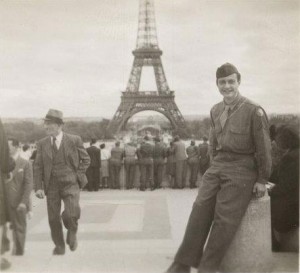
Roy Lichtenstein in Paris, France, ca. 1945.
The Roy Lichtenstein Foundation Archives
June Sent to Oberammergau, a picturesque German town in the Bavarian Alps. There works at the Army’s Information and Education School. Prepares and delivers half-hour lectures on the War in Europe and the Pacific as well as the Japanese Army based on information he reads in Fortune magazine.
July Paints in gouache.
Sept. Travels by rail to Paris on a three-day pass and visits the Louvre Museum. Remarks on El Greco’s Christ on the Cross Adored by Two Donors (c. 1590; Musée du Louvre, Paris), Cézanne’s The Card Players (1890–92; the Metropolitan Museum of Art, New York)
and Daumier’s La blanchisseuse (1863; Musée d’Orsay, Paris). At the Louvre bookshop, buys a small book on Fauvist Georges Rouault. In a letter home, writes of doing stacks of drawings and of intention to study painting, citing Picasso, Rouault and Henri Matisse. Buys books on Francisco Goya’s etchings and Georges Seurat’s paintings, even though he later remarks that he was not that inspired by latter’s work.
Oct. 15 Selected to attend a French Language and Civilization course at the Sorbonne in Paris through the Army’s civilian agency AEP program. Begins classes in late October where he resides at the Cité Internationale Universitaire de Paris on Boulevard Jourdan located in the southern outskirts of the city. Passes Picasso’s studio on Rue des Grands-Augustins but decides not to intrude. Completes four hundred hours.
Dec. 2 Leaves Europe for the United States.
Dec. 5 Reports home to Fort Dix, New Jersey, after learning that his father is very ill.
1946
Jan. 11 Is discharged from the Army with the rank of PFC (Private First Class) as a Draftsman 070 and returns home. Regularly visits the Metropolitan Museum of Art and MoMA with mother and sister.
Feb. 13 Milton Lichtenstein dies.
Mar. Returns to OSU to complete degree. Courses include History of Renaissance Art and Watercolor Painting.
June Receives BFA degree from OSU, College of Education, School of Fine and Applied Arts. Lives and works in a small room in a converted mess hall off campus.
Sept. Joins OSU School of Fine and Applied Arts faculty as an instructor.
Oct. Teaches drawing and design courses. Creates own version of a flash lab, stacking boxes in a darkened room and asking students to draw the afterimage using charcoal or crayon on paper.
Lives at 804 Neil Avenue in downtown Columbus.
Creates stonelike sculptures from Hydrocal, a castable plaster product. Figures have Picassoesque features but seem almost pre-Columbian in style. Tries painting geometric abstractions in the style of Piet Mondrian, but with a different palette. Fewer than ten canvases were made and they were later destroyed.
1947
Jan. Enrolls in the Graduate School of Fine and Applied Arts at OSU. Travels with Charles Csuri to see various art exhibitions in New York.
Spring Classes include Technical Problems and Water Color Painting with Bradley.
Occasionally returns to New York with friends Stanley Twardowicz and Csuri to visit galleries, especially Charles Egan and Betty Parsons Galleries.
Paintings of this period depict bulbous figures with animated features. Continues to work in ceramic; details emulate Joan Miró. Found object pieces have a Paul Klee–like quality.
Gets a centrifuge casting machine to create silver jewelry using lost wax process. Buys a small electrical kiln for enameling.
Fall Enrolls in Advanced Research Problems and Research in Art History: Criticism and Philosophy of Art.
1948
Fall Classes include Art History Research and Criticism.
Produces pastels, oils and drawings. Subjects include musicians, landscapes and fairy tales.
Begins showing work at the new location of the Ten-Thirty Gallery, located on the third floor of the State Theater Building in Cleveland. Algesa O’Sickey is one of the directors and is the wife of faculty colleague Joseph O’Sickey. Modernist architect Robert Little provides the sketches for the L-shaped floor space.
1949
March Receives MFA from OSU. Completes MFA thesis, “Paintings, Drawings, and Pastels,” which includes a series of poems celebrating various artists, including Matisse, Klee, Picasso, Rousseau, Cézanne, van Gogh, Gauguin, Lautrec, Rembrandt and the Song Dynasty painter Ma Yuan.
June 12 Marries Isabel Sarisky (née Wilson b. July 26, 1921 in Van Wert, Ohio; d. Sept. 25, 1980), assistant director at Ten-Thirty Gallery (1515 Euclid Avenue, Cleveland, OH), whom he meets through the O’Sickeys earlier that year. She is recently divorced from prominent Cleveland artist Michael Sarisky, (b. 1906; d. January 12, 1974). He was born in Czechoslovakia and he and his parents immigrated to the United States in 1913. He was a figurative painter who created murals for the United States Treasury Department and whose oils were included in exhibitions at the Whitney Museum of American Art and the Corcoran Gallery. Richard Gosminski takes over Isabel’s role as assistant director when she moves to Columbus and she begins to paint. Algesa O’Sickey steps down as director in December.

Roy Lichtenstein in his Columbus, Ohio studio, ca. 1949. Photographer Unknown
Summer Begins class work toward PhD, taking courses in Minor Problems in Painting, Technical Problems: Painting and Minor Problems: Arts Education.
Aug. 1–31 First group exhibition in New York, at Chinese Gallery (38 E. 57th St.), which shows American art along with classical Chinese art forms, including ceramics.
Fall Takes painting classes with Sherman and Grimes.
Dec. 12–30 Ten-Thirty Gallery exhibits twenty oils and pastels along with work by ceramists Harry Schulke and Charles Lakosky. Works are described as “flat abstracts with objects like animals, plants and faces being faintly recognizable.”
Borrows book on nineteenth-century American painter George Catlin from colleague Roy Harvey Pearce. North American Indian themes begin to appear in paintings and drawings beginning in 1950.
1950
Rents a two-story house at 1496 Perry Street in Columbus with Isabel, which doubles as a studio. Begins to use paint cans full of sand to counterbalance an old easel in order to rotate canvases. Uses a mirror to see paintings upside down to abstract the subject matter and concentrate on compositional unity.
Summer Takes Mural Painting; Research: Oil and Watercolor Painting; and final Technical Problems class.

Roy Lichtenstein and Isabel Lichtenstein in Columbus, Ohio, ca. 1950.
Photograph by Stanley Twardowicz
July 28 Denied tenure at OSU due to lack of “substantial growth.”
Giant beetles, flowers and birds along with medieval imagery account for much of subject matter. Influenced by a friend’s book on the Bayeux Tapestry.
Aug. Woodcut To Battle (1950; edition of 10) takes first prize at the Ohio State Fair.
Isabel finds work at Arts and Crafts, the interior design department of Tibbals-Crumley-Musson Architects; coordinates exhibitions of artisan jewelry and ceramics.
Regularly attends jazz to Philharmonic performances in Columbus. Teaches himself to play the flute.
1951
Starts to bring paintings to galleries in New York, such as M. Knoedler and Sidney Janis, transporting them on top of car. During his teaching years, goes to Cedar Tavern on University Place and sometimes talks to artists such as Jackson Pollock, Mark Rothko, Willem de Kooning, Franz Kline and Barnett Newman, but is too shy to really get to know them.
Mar. 21–May 20 To Battle is exhibited in a Brooklyn Museum juried show, Fifth National Print Annual Exhibition, and receives a museum purchase award.
Apr. 30–May 12 First solo exhibition in New York, at Carlebach Gallery (937 Third Ave.), which includes twenty oils and pastels; five prints rendered in muted pinks, blues and mauves; and four assemblages made from wood found from packing crates, metal pieces and found objects such as screws and drill buffers.
June Moves to Cleveland and sets up home and studio on the second floor of the Music Center Building at 1150 Prospect Avenue, across from Gray’s Armory. Isabel finds work as an assistant interior decorator at Jane L. Hanson, Inc.
Paints an “Early Renaissance”–style self-portrait.
Notebook is filled with cartoonlike drawings of things such as bananas.
Aug. Knight on Horseback (1951; private collection) takes first prize in sculpture at the Ohio State Fair.
Draws clowns and other fairground scenes in sketchbooks.
Dec. 2 Exhibits “colorful” silk-screen prints for the Craftsman Christmas exhibition of the Art Colony Galleries in Cleveland.
Dec. 31–Jan. 12, 1952 Solo exhibition at John Heller Gallery in New York (108 E. 57th St.), consisting of sixteen paintings based on American frontier themes and several self-portraits as a knight. Sherman contributes a brief preface to the show’s brochure. One painting in the show, Death of the General (1951; private collection, New Jersey), is reproduced in Artnews and Art Digest.
Shows jewelry at the Bertha Schaefer Gallery in New York (32 E. 57th St.).
Begins to incorporate titles and advertising copy in woodcut compositions and paintings such as Emigrant Train—after William Ranney (1951; private collection).
1952
Mar. 2–22 Solo exhibition of seventeen works (paintings, drawings and prints) at the Art Colony Galleries. One pencil drawing, which includes a photo of a castle taped onto it, is described by a Cleveland News art critic as “truly like the doodling of a five-year-old.” Is referred to as an “odd talent”; show elicits mixed responses.
Fall Contributes work to juried exhibitions, including Denver City Building (Insect with Man [1950; private collection]), the Pennsylvania Academy of the Fine Arts (Hunter with Dog [1951; edition of 10]), and the University of Nebraska (A Cherokee Brave [1952; edition of 17]). A charcoal of that year, a study for Two Indians (1952; location unknown) is included in a show at the Metropolitan Museum of Art.
Decorates display windows and floors part-time at a Halle Brothers’ Euclid Huron department store.
1953
Jan. 26–Feb. 7 Second solo exhibition at John Heller Gallery, consisting of oils and watercolors based on Americana themes. The Statesman (1951; private collection) is reproduced in Artnews (titled The Diplomat) in black and white and reviewed by Fairfield Porter.
Sept. 20–Oct. 5 Contributes work to the third season opening exhibition of the Art Colony Galleries.
Nov. Receives an award for woodcut A Cherokee Brave in the Contemporary Printmaking Exhibition at OSU.
Works from his apartment at 11483 Hessler Road in Cleveland. Audits classes at the Cleveland Institute of Art.
1954
Moves to an apartment at 1863 Crawford Street in Cleveland. Teaches drawing at the Cooper School, a commercial art school in Cleveland. Designs logo featuring a knife, spoon and fork for Hydecker Industrial Caterers, Inc., a commercial catering company run by his friends Margaret and George (Hy) Silverman.
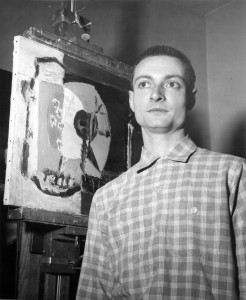
Roy Lichtenstein in his home studio in Cleveland, Ohio, mid-1950s.
Photograph by Ray Sommer
Mar. 8–27 Third solo exhibition at John Heller Gallery, consisting of paintings on American folklore themes and others that feature depictions of clock and gear parts, based on engineering blueprints that echo French’s Engineering Drawing, illustrated by Sherman. Some works include toys. Critics Robert Rosenblum and Porter review the show for Art Digest and Artnews, respectively.
Oct. 7–24 Included in Cleveland Museum of Art’s show of “spontaneous and unrehearsed” drawings by local artists, although his works are consistently rejected for the museum’s coveted invitational May show.
Oct. 9 Son David Hoyt Lichtenstein is born.
Mid-1950s Creates mosaic tabletops for clients of Isabel, with welding done by a friend.
1955
Jan. 1 Weatherford Surrenders to Jackson (1953; private collection) is purchased by collectors and donated to the Butler Museum of American Art in Youngstown, Ohio.
Jan. 9 The Art Colony Galleries exhibits thirteen paintings in a three-person show that also includes Christine Miller and Louis Penfield. One critic describes paintings in the show as “Klee-like and surprising.”
Oct.–Nov. Displays jewelry at the Brooklyn Museum Gallery Shop.
Creates several wall-mounted assemblages of painted wood.
Works on the “before” models of a low-income Cleveland neighborhood for a proposed renovation project designed by Little and photographed by Margaret Bourke-White for Life magazine. One contribution is to paint graffiti in the miniature alley.
1956
Creates first proto-Pop work, a lithograph called Ten Dollar Bill (Ten Dollars) (1956; edition of 25).
Returns to imagery of the Wild West.
Mar. 10 Son Mitchell Wilson Lichtenstein is born.
Mechanism, Cross Section (1954; Flint Institute of Arts) is purchased by the same collectors who bought Weatherford Surrenders to Jackson and is donated to the Flint Institute of Arts.
1951–57
Works at various jobs in Cleveland, most lasting about six months each. Hand-paints black-and-white dial markings on volt and amp meters for Hickok Electrical Instrument Co. Travels frequently to New York. Introduced by Stanley Landesman to Herman Cherry and Warren Brandt.
1957
Buys first home at 2421 Edgehill Road in Cleveland Heights and sets up a studio there.
Works as an engineering draftsman making furniture in the Product and Process Department at Republic Steel Company.
Jan. 8–26 Solo exhibition at John Heller Gallery, consisting of paintings on Americana themes. Works described by critics as “acrid in color,” “flatly patterned . . . spontaneously felt depictions of a grown-up’s child-world.”
Feb. Invited to exhibit with Group 5, an association of Cleveland artists who banded together in defiance of their omissions from the May show at the Cleveland Museum of Art. Lichtenstein shows several paintings and constructions.
May Shows lithographs at Karamu House, Cleveland, where different races, religions and creeds practice dance, printmaking, theater and writing.
Summer Offered assistant professorship of art at State University of New York (SUNY) at Oswego to teach industrial design. Hoping to get closer to New York, accepts the position.
Moves home and studio to 11 W. Sixth Street in Oswego, where his family shares a two-family house.
Uses an opaque projector to trace a large image of Mickey Mouse on son Mitchell’s bedroom wall.
Abstract Expressionist style appears in paintings, which include renderings of cartoon characters such as Mickey Mouse, Donald Duck and Bugs Bunny. Later recalls that these canvases were used as drop cloths for first Pop-inspired works.
Style changes to a lyrical abstraction with hatched brushwork featuring images found in books of eighteenth-century French salon paintings of François Boucher, Jean-Baptiste Greuze, Antoine Watteau and rococo oils of Jean-Honoré Fragonard, among others.
1958
May Six oil paintings are among those Heller sends for an exhibition in Los Angeles.
June Approaches Csuri’s dealer in New York, Harry Salpeter, whose gallery is across from Heller’s on 57th Street, about representation. Salpeter turns him down.
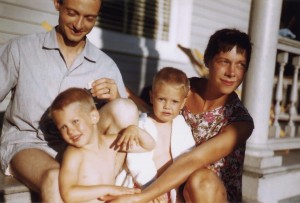
Aug. Teaches Industrial Art Design summer course at SUNY Oswego and graduate course in painting. Hosts salon-style open-house evenings for students.
Creates drawings based on Mickey Mouse and Donald Duck using brush and india ink.
Leaves John Heller. Participates in a group show at Condon Riley Gallery in New York (24 E. 67th St.). Housed in a Beaux-Arts–style townhouse a floor below the Tibor de Nagy Gallery, the gallery space featured walls that simulated dark velvet with a floating ceiling that hid the lighting.
1959
Moves with family to 52 Church Street in Oswego. Maintains a studio in one of the bedrooms. Continues to teach Industrial Arts during the summer and graduate courses in painting.
Mar.–mid-Apr. Exhibits oil painting in Sixth Annual Central Art Exhibition at the Syracuse Museum of Fine Arts.
Spring Contributes the cover design for Polemic, one of two prints done for the magazine published under a grant from the Adelbert College Student Council at Western Reserve University, Cleveland. His highly abstract image in black with the title of the magazine in red lettering is hand printed by a commercial printer on a letterpress.
June 2–27 Untitled lyrical abstractions are shown for the first time in a solo exhibition at Condon Riley Gallery in New York (24 E. 67th St.). Paintings feature scant traces of bright color on an unprimed background; some contain heavy impasto and traces of instant coffee. Described as washy, waterish, abstract, thinly painted.
Using a tea towel wrapped around his arm, which he dips in three of four oil colors laid next to each other on a glass palette, embarks on a series of abstract works that look like chunky multicolored ribbons created by dragging the rag in one direction and then another until all the paint is used, and repeating the process with different variations of color. Employs a charcoal nib dipped in paint to create calligraphic lines on some of the canvases and a rag to soften edges.
1960
Spring Resigns from SUNY Oswego after accepting assistant professorship of art at Douglass College, Rutgers, State University of New Jersey. Teaches Art Structure and Design and Advanced Design beginning July 1. Shares an office with Geoffrey Hendricks. Robert Miller, a future dealer, serves as his teaching assistant.
Moves into a house at 66 S. Adelaide Avenue, Highland Park, New Jersey, where he sets up his studio in the bedroom. Bolts a two-by-four to the ceiling, to which he attaches clip-on lights. Paintings are hung throughout the house.
June 6–24 Sees works by Jim Dine and Claes Oldenburg at the Martha Jackson Gallery, New York, in New Form—New Media I, organized by Steve Joy.
Fall Introduced by colleague Allan Kaprow to Oldenburg, Lucas Samaras, George Segal (then completing his MFA) and Robert Whitman. Through Robert Watts, another professor in the department, meets George Brecht, Dick Higgins, Alison Knowles and George Maciunas, all artists who will be involved with Fluxus.
Attends some of Kaprow’s informal happenings.
Hangs untitled abstract canvases in former student Tom Doyle’s building so he can show them to Henry Geldzahler, curator at the Metropolitan Museum, and Ivan Karp of the Leo Castelli Gallery, but Doyle forgets to unlock the door to the building. Brings them to Leo Castelli Gallery and shows them to the dealer and his former wife, Ileana Sonnabend.
1961
Jan. Shows Kaprow the semiabstract paintings with cartoon figures embedded in paint which he later recalls using as drop cloths for his Pop paintings.
Jan. 11–27 At Douglass College, exhibits twelve abstract ribbon paintings. One work is painted on several pieces of refrigerator-crate plywood nailed together.
Feb. Meets Art Department secretary Letty Lou Eisenhauer.
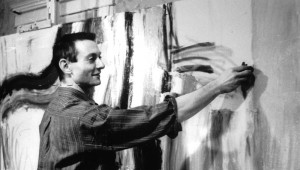
Roy Lichtenstein in his studio at Douglass College, Rutgers, the State University of New Jersey, New Brunswick, NJ, ca. 1961.
Photograph by Samuel Weiner/Used by permission
June Tells Eisenhauer about his new painting Look Mickey (1961, National Gallery of Art, Washington, D.C.) (based on an image in one of his children’s Little Golden Books). First Pop works demonstrate what the artist refers to as paintings without any expressionism in them. Pushes oil paint through the holes of a plastic dog-grooming brush without its bristles to create dot effect. Works feature blown-up versions of advertised consumer goods and other well-known characters including Popeye and Wimpy, as well as panels from the comic strips Buck Rogers, Steve Roper and Winnie Winkle. Experiments with other ways to apply dots, from using a lightly loaded paintbrush, which he drags over the canvas, to employing a small, square, handmade stencil made from thin aluminum with hand-drilled holes. Uses pre-primed white canvas. Flat areas are done in primary oil paint colors and outlined with black. Some paintings are done exclusively in black and white or blue and white. Creates several diptychs joined with hinges.
Works on a series of finished black-and-white drawings in pen, felt-tip marker, brush and india ink. Some feature pochoir, a stenciling technique of pushing india ink through a small metal grid. Three-color drawings entitled Baked Potato (1961; private collection) feature synthetic polymer paint.
Fall Kaprow arranges a meeting with Ivan Karp, director of Leo Castelli. Brings The Engagement Ring (1961; private collection), Girl with Ball (1961, The Museum of Modern Art, New York), Look Mickey and Step-on Can with Leg (1961, private collection). Castelli contacts the artist several weeks later and agrees to represent him. In the meantime Ileana Sonnabend visits the Highland Park studio together with Billy Klüver. Irving Blum also visits. Sonnabend and Blum offer to represent him.
Separates from Isabel and moves for a brief period of time into a studio on Broad Street near Coenties Slip, his first studio in New York.
Sept. 22–Oct. 14 Girl with Ball is added to Castelli’s show An Exhibition in Progress (Bontecou, Chamberlain, Daphnis, Higgins, Johns, Langlais, Moskowitz, Rauschenberg, Scarpitta, Stella, Twombly, Tworkov). Is the first public showing of one of his Pop works. The show’s concept is to start with a group of works and slowly replace them with Robert Rauschenberg’s works until it becomes a full Rauschenberg show, and then begin to slowly replace Rauschenberg’s works with others’ until it turns back into a group show by the end of its run.
Oct. Consigns first works for sale to Castelli, including Washing Machine (1961; Yale University Art Gallery, New Haven), Emeralds (1961; private collection), Roto Broil (1961; Museum of Contemporary Art, Teheran) and Keds (1961; The Robert B. Mayer Family Collection, Chicago, Illinois).
Nov. Mr. Bellamy (1961; Modern Art Museum of Fort Worth), Yellow Garbage Can (1961; private collection), Red Flowers (1961; private collection), Step-on Can with Leg, Black Flowers (1961; Eli and Edythe L. Broad Collection), I Can See the Whole Room! . . . And There’s Nobody in It! (1961, private collection), Girl and Rope Ladder (1961; lost/presumed destroyed), Cup of Coffee (1961; Roy Lichtenstein Foundation Collection) and Bread with Bag (1961; Städtisches Museum Abteiberg, Mönchengladbach) are sent to Castelli for sale.
Nov. 9 Castelli sells his first work I Can See the Whole Room! . . . and There’s Nobody in It! to Burton and Emily Hall Tremaine of Meriden, Connecticut.
Nov. 30 New York collector Richard Brown Baker buys Washing Machine.
Dec. A third wave of works is consigned to Castelli, including Turkey (1961; private collection), Roller Skates (1961; private collection), Electric Cord (1961; private collection), Bathroom (1961; private collection) and Transistor Radio (with Metal Antenna) (1961; private collection), which includes an actual aerial antenna.
Dec. 12 Chicago collector Walter Netsch buys Black Flowers.
Meets Rauschenberg and Jasper Johns.
Makes “duplicate” portraits of Kaprow and Karp.
Warhol takes his own paintings to Leo Castelli and shows them to Karp. Karp shows Warhol Girl with Ball.
With Karp, visits Warhol’s studio at 1342 Lexington Avenue in New York and sees Warhol’s comic-strip and consumer-goods paintings.
1962
Returns to live and work in Highland Park.
Experiments with acrylic emulsion paint, in particular, Liquitex, but quickly abandons it for Magna, a polymer-based paint manufactured by Leonard Bocour that is soluble in turpentine but without the “yolky” or “milky” quality of Liquitex. Uses a Magna-based varnish between coats. Because Magna dries too quickly, continues to use oil paint for simulated Benday dots and, later, diagonals. Begins to use an industrial perforated metal screen, which he finds through the Beckley Perforating Co. in Garwood, N.J., for his Benday dots. Most works begin with colored pencil drawings to organize the material, done either sitting in a chair or at the drafting table. Enlarges drawings or sometimes even the source on the canvas using a Postoscope projector which he then redraws using a rotating easel or mirror to further abstract the image. Pencil marks unerased in earlier works begin to disappear entirely from compositions.
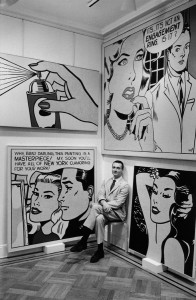
Roy Lichtenstein at Castelli Gallery sitting with Spray (1962), Masterpiece (1962), Engagement Ring (1961) and Aloha (1962), 1962.
Photograph by Bill Ray
Close cropping of imagery appears.
First paintings based on panels from All-American Men of War comics, such as Blam (1962; Yale University Art Gallery, New Haven) and Takka Takka (1962; Museum Ludwig, Cologne, Germany). The five-panel work Live Ammo features one diptych and three other panels; the painting is later broken up and sold as four individual works.
First paintings based on reproductions of works by Picasso and Cézanne, including Portrait of Madame Cézanne (1962; private collection), an enlarged version of a black-and-white outline diagram by Cézanne scholar Erle Loran.
Isolates the words Art (1962; private collection) and In (1962; Solomon R. Guggenheim Museum, New York) on canvas. Later recalls wanting to make one with the word “Flat” but soon abandons the idea.
Makes first commissioned print, On (1962; edition of 60), for Klüver and noted Dada and Surrealist expert Arturo Schwartz for The International Anthology of Contemporary Engravings: The International Avant-Garde: America Discovered, Volume 5 (Galleria Schwartz, Milan). Published in 1964, the portfolio also contains Warhol’s first print.
Switches from ink to pencil for finished black-and-white drawings. Develops a frottage technique for black-and-white drawings by placing a sheet of paper on a window screen and rubbing it with graphite to achieve the look of machine-applied dots. Finished drawings often depict subjects different from those in paintings and do not require preliminary sketches. Simultaneously works on paintings and these drawings in no clear chronological order.
Feb. 10–Mar. 3 First solo show of paintings at Leo Castelli, featuring works such as Turkey, Washing Machine, The Engagement Ring, The Kiss (1961; private collection), The Refrigerator, Blam and The Grip (1962; Museum of Contemporary Art, Los Angeles).
Feb. 26 Newsweek magazine reviews Leo Castelli show and reproduces Girl with Ball.
Mar. Is linked for the first time with Dine, Oldenburg and James Rosenquist as a cohesive group (together with Peter Saul and Watts) in Max Kozloff’s article, “‘Pop’ Culture, Metaphysical Disgust, and the New Vulgarians,” in Art International.
Apr. Donald Judd reviews Leo Castelli show for Arts magazine.
Apr. 3–May 13 The Kiss is included in 1961, a group exhibition at the Dallas Museum for Contemporary Arts curated by Douglas MacAgy.
May Consigns a number of black-and-white pencil drawings to Castelli.
May 26–June 30 Black-and-white drawings are shown for the first time in Drawings: Lee Bontecou, Jasper Johns, Roy Lichtenstein, Robert Moskowitz, Robert Rauschenberg, Jack Tworkov at Leo Castelli.
June 15 Among several artists featured in “Something New Is Cooking” in Life magazine.
Aug. 6–31 Art of Two Ages: The Hudson River School and Roy Lichtenstein at Mi Chou Gallery in New York (801 Madison Ave.) features Golf Ball (1962; private collection), Electric Cord, drawing Zipper (1962; private collection), Bratatat! (1962; The Charles Simonyi Collection), The Refrigerator, Ice Cream Soda (1962; private collection) and Takka Takka, along with paintings by Albert Bierstadt, John William Casilear, Frederic Edwin Church, Jasper Cropsey and Asher B. Durand. Chou borrowed the nineteenth-century works from Kennedy Galleries in New York.
Sept. Included in Artnews essay, “The New American ‘Sign Painters,’” by Gene R. Swenson, along with Dine, Stephen Durkee, Robert Indiana, Rosenquist, Richard Smith and Warhol.
Sept. 25–Oct. 19 Comic-strip and consumer-goods paintings are shown on the West Coast for the first time in the group exhibition New Painting of Common Objects at the Pasadena Art Museum, curated by Walter Hopps.
Oct. 25–Nov. 7 Included in Art 1963—A New Vocabulary, organized by Joan Kron and Audrey Sabol for the Art Council of the YM/YWHA in Philadelphia, which features paintings, collages, assemblages, combines and machines by Brecht, Dine, Johns, Kaprow, Marisol, Oldenburg, Rauschenberg, Rosenquist, Segal, Jean Tinguely and Watts. Exhibition brochure includes statements by the artists and a dictionary of terms written by Klüver to describe the new art. Contributes a handwritten word balloon with the words “DYNAMIC: KPOW! WHUMP! TAKKA TAKKA!! VAROOM!”
Oct. 31–Dec. 1 Included in Sidney Janis Gallery exhibition International Exhibition of the New Realists, featuring “factual paintings and sculpture” by American and European artists, along with Dine, Klein, Oldenburg, Rosenquist, Mimmo Rotella, Segal, Tinguely and Warhol.
Nov. Swenson publishes “What Is Pop Art? Answers from Eight Painters, Part I: Jim Dine, Robert Indiana, Roy Lichtenstein, Andy Warhol,” in Artnews. Featured speaker for a session entitled “‘Sign’ Painters” for the eighteenth annual design conference of the American Society of Industrial Designers at the Waldorf Astoria.
Work is included for the first time as part of the MoMA’s Art Lending Service.
Nov. 18–Dec. 15 Takka Takka is included in My Country ’Tis of Thee at the Dwan Gallery in Los Angeles, along with works by Indiana, Johns, Edward Kienholz, Marisol, Oldenburg, Rauschenberg, Larry Rivers, Rosenquist, Warhol and Tom Wesselmann.
Head—Red and Yellow (1962; Albright-Knox Art Gallery, Buffalo) is acquired by the Albright-Knox Art Gallery.
Dec. 4 On “The Unpopular Artist in a Popular Society” panel held in New York.
Dec. 13 Attends symposium on Pop art at MoMA. Speakers include Dore Ashton, Henry Geldzahler, Hilton Kramer, Stanley Kutz and Leo Steinberg, with Peter Selz as moderator. “Pop” art is chosen as name for the new movement. Other artists in the audience include Duchamp, Maciunas, Rosenquist and Warhol.
Dec. 26 Among eleven artists chosen to create an outdoor mural for Johnson’s Theaterama building, part of the New York State Pavilion at the World’s Fair in Flushing Meadows, 1964–65.
1963
Begins series of canvases depicting women from the DC Comics Girls’ Romances and Secret Hearts series. Benday dots are doubled in areas such as lips by shifting the screen. Some are done in red and blue to create the effect of purple. Several canvases feature mad scientists from science fiction comic books.
Hires assistant to paint in Benday dots.
Begins to use lithographic rubbing crayon in his finished black-and-white drawings to achieve larger, more uniform, machine-looking dots.
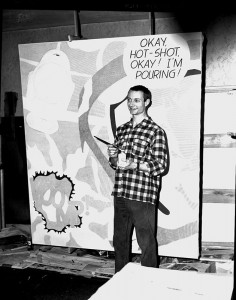
Roy Lichtenstein working on Okay, Hot-Shot, Okay! (1963) in his studio in Highland Park, New Jersey, ca. 1963.
Courtesy Special Collections and University Archives, Rutgers University Libraries
Mar. 14–June 12 Included in Six Painters and the Object at the Solomon R. Guggenheim Museum, organized by Lawrence Alloway, along with Dine, Johns, Rauschenberg, Rosenquist and Warhol. The show travels throughout the United States.
Apr. Three paintings are included in Pop! Goes the Easel at the Contemporary Arts Museum, Houston, organized by MacAgy.
Apr. 1–20 First exhibition at Ferus Gallery in Los Angeles, featuring Sock (1962; private collection), Masterpiece (1962; private collection), Sponge (1962; private collection), Sponge II (1962; private collection), Portrait of Madame Cézanne and Drowning Girl (1963; The Museum of Modern Art, New York), as well as other works from 1962–63.
Apr. 18–June 2 Electric Cord, Handshake (1961; private collection), George Washington (1962; private collection), Aloha (1962; The Helman Collection), The Refrigerator and Femme d’Alger (1963; The Eli and Edythe L. Broad Collection, Los Angeles) are included in The Popular Image at the Washington Gallery of Modern Art, organized by Alice Denney.
Apr. 28–May 26 Leo Castelli lends Girl at Piano (1963; private collection) and Magnifying Glass (1963; cat. 25) for Popular Art: Artistic Projections of Common American Symbols at the William Rockhill Nelson Gallery of Art and Atkins Museum of Fine Arts, Kansas City.
May 10–June 20 Included in first European group show, De A à Z: 31 Peintures américains choisis par the Art Institute of Chicago, at the American Cultural Center in Paris. The Ring (Engagement) (1962; Stefan T. Edlis Collection, Chicago) is included.
May 17 Time magazine publishes a letter by William Overgard stating that I Can See the Whole Room! . . . And There’s Nobody in It! is taken from the last panel of his August 6, 1961, comic strip Steve Roper. Overgard’s panel and the painting are reproduced side by side.
June Commissioned by poet Walasse Ting to contribute a piece for the cover of his collection of writing entitled 1¢ Life.
June 5–30 First solo exhibition in Europe, at Galerie Sonnabend in Paris (37, quai des Grands-Augustins). Trip to Paris for the opening is first time back since the war.
Summer–Winter Works are included in shows in Lausanne, Toronto, London, Turin, Stockholm and Gstaad.
Summer Brings the family to Provincetown, Massachusetts, where he spends time with Karp and his family.
Takes leave of absence from Douglass College.
Sept. 28–Oct. 24 Second solo exhibition at Leo Castelli includes Drowning Girl, Baseball Manager (1963; private collection), Torpedo . . . LOS! (1963; cat. 34) and Whaam! (1963; The Tate Gallery, London).
Oct. First of a series of major interviews conducted by John Coplans appears in Artforum.
Oct. 1 Sells Highland Park home. Separates from Isabel, who moves with the children to Princeton.
Moves with Eisenhauer to the second floor of 36 W. 26th Street, which doubles as a studio.
Oct. 24–Nov. 23 Pop works are shown for the first time in Britain in The Popular Image at the Institute of Contemporary Art, London, organized by Alan Solomon.
Nov. 19–Dec. 15 Included in Mixed Media and Pop Art at the Albright-Knox Art Gallery, organized by Gordon M. Smith, along with Dine, Johns, Oldenburg, Rauschenberg, Rosenquist and Warhol, as well as lesser-known artists in the museum’s collection.
Completes first work in Magna on Plexiglas. Makes several more on plastic, which appeals to interest in achieving an “antiseptical industrial look.”
1964
Jan. 31 Life magazine publishes article entitled “Is He the Worst Artist in the U.S.?” The idea comes from author Dorothy Seiberling, who at the time was married to Leo Steinberg. Both are supporters of the artist, who approves of the idea for the title.
Begins to prime own canvases by wiping them with tape to remove lint and applying two thin coats of gesso and one thin coat of white underpainting.
Makes full-scale canvases of composition notebooks and works that bear close resemblance to Mondrian’s abstractions.
Begins to make Benday dots larger, in proportion to the size of canvases.
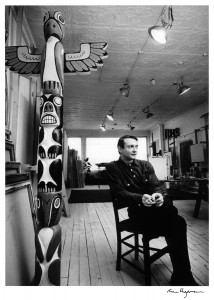
Roy Lichtenstein in his studio at 36 West 26th Street, New York, 1964.
© Ken Heyman/Courtesy Roy Lichtenstein Foundation Archives
Creates a series of frightened and crying women in close-up views.
Dialogue balloons begin to disappear from paintings.
Employs an airbrush for the first and only time to create Duridium (1964; private collection), which depicts a razor blade.
Begins series of cartoon-style landscapes and seascapes inspired by cartoon backgrounds. Creates first sunrise and sunset works. Increasingly invents own subject matter.
Buys several mannequin heads and paints one like a cartoon girl.
Apr. Invited by National Cartoonists Society in New York to talk about work.
His cover design for Art in America features a “pop panorama” drawing of the 1964–65 New York World’s Fair.
Apr. 22 World’s Fair Mural (1964; University Art Museum, Minneapolis) of a girl in a window is among the murals featured at the New York State Pavilion at the New York State Fair.
Spring Meets Dorothy Herzka (b. 1939) at Paul Bianchini Gallery in New York (16 E. 78th St.) during preparations for American Supermarket, organized by Ben Birillo.
Introduced to a polycarbonate optical paper, Rowlux, by Jerry Foyster, and soon experiments with it in collages.
With help from Birillo, fabricates first enamel pieces on butcher trays featuring a red-and-white image of a hot dog. Creates first enamel edition, Hot Dog (1964; edition of 10), inspired by the enameled look of a Good Humor truck and subway signs.
Seeks out ARPOR (Architectural Porcelain Fabricators, Inc.) in Orangeburg, New York, to create enameled works featuring cloudscapes, sunsets and scenes of girls based on comic-book panels.
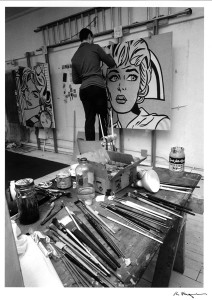
Roy Lichtenstein working on his painting, Nurse (1964) in his studio at 36 West 26th Street, New York.
© Ken Heyman/Courtesy Roy Lichtenstein Foundation Archives
June Included in Bruce Glaser roundtable radio discussion on New York WBAI that includes Oldenburg and Warhol. The transcript is published in Artforum (Feb. 1966).
June 30 Resigns from Douglass College.
Oct. 6 Grand opening of American Supermarket, which includes works by a number of artists. Visitors can buy items and put them in shopping bags with his image of a Thanksgiving turkey or one by Warhol featuring Campbell’s tomato soup. The show eventually travels to Rome and Venice, where it also features his enamel edition Hot Dog.
Oct. 24–Nov. 19 Temple of Apollo (1964; private collection, St. Louis), employing a classical art reference, is shown at Leo Castelli, along with several landscapes and enamel works.
Oct. 31 Attends Idelle Weber’s Halloween party on Livingston Street in Brooklyn Heights dressed as Warhol with Herzka dressed as Edie Sedgwick.
Nov. 24 Solo exhibition of landscapes and girls at Ferus Gallery, Los Angeles. Dennis Hopper takes photographs of him at the gallery.
Dec. 7 Makes “Spear-Bearer” costume in which he performs with Eisenhauer and others in Dick Higgins’s restaging of Dzhoneš’s opera Hrusalk at the Café au Go Go in New York.
Klüver and Schwartz publish The International Anthology of Contemporary Engravings: The International Avant-Garde: America Discovered, Volume 5 (Galleria Schwartz, Milan).
Rosa Esman begins Tanglewood Press with the portfolio New York Ten, which includes Seascape (1964, published 1965; edition of 200), his first color screen print on Rowlux.
Samuel J. Wagstaff, Jr., the Curator of Paintings, Prints, and Drawings, of the Wadsworth Atheneum in Hartford, Connecticut, invites him to contribute a screen print which he makes on clear plastic entitled Sandwich and Soda (1964; edition of 500) to the portfolio X + X (Ten Works by Ten Painters). Ugo Mulas photographs him in the studio working on the print. An edition is sent to the American Embassy in Warsaw, Poland.
1965
Officially separates from Isabel.
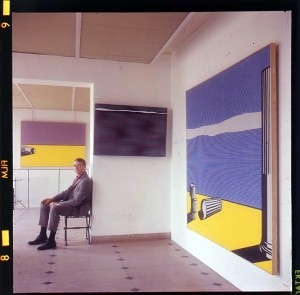
Roy Lichtenstein at Galerie Sonnabend, Paris, for the opening of his show in June 1965.
Photograph: Shunk-Kender. © J. Paul Getty Trust. † The Getty Research Institute, Los Angeles (2014.R.20)
Gift of The Roy Lichtenstein Foundation in memory of Harry Shunk and Janos Kender
Begins collaboration with Rutgers colleague and potter Hui Ka Kwong to create a series of ceramic heads and another of stacked cups and saucers based on diner cutlery and glassware. Molds for the dishes are purchased from Stewart Clay Company and the Holland Mold Company, both in New York. Employs decals of ceramic dots which he has commercially silk-screened which can be cut to the desired configurations. For heads he devises punched-out tape stencils which Hui can spray color through evenly to their contours. Black lines are painted by hand. Uses gold and silver paint in several ceramics featuring teapots.
Ken Heyman’s photo of Look Mickey being unrolled by the artist in his studio appears for the first time in John Rublowsky’s Pop Art, the first book devoted to the movement.
Experiments with Modern motifs in poster of the World’s Fair for the National Cartoonists Society entitled This Must Be the Place (1965; edition size unknown).
Dealers Marian Goodman, Ursula Kalish and Sunny Sloane, along with art consultant and framer Barbara Kulicke, establish Multiples, Inc., for editioned pieces of art. They had already opened the Betsy Ross Flag and Banner Company in 1962 with Robert Graham of New York’s Graham Gallery to produce banners by artists. Pistol (1964; edition of 20) is the most popular and sells out.
Founded by Daniel Spoerri, Èditions MAT in Paris publishes his boxed Rowlux entitled Seascape (II) (1965; edition of 65) in their portfolio Collection 65.
Jan. The Stedelijk Museum in Amsterdam purchases As I Opened Fire, 1964.
Mar. 13 Contributes to the Artist’s Key Club, a happening orchestrated by Arman, where 104 keys to 104 Penn Station lockers are sold at the Chelsea Hotel in New York. Each locker has one signed work or one small gift by the participating artists. Contributes four signed drawings and four anonymous toys.
Apr. Creates three screen prints, Moonscape, Reverie and Sweet Dreams Baby! (all 1965; each in an edition of 200), commissioned by Philip Morris, for 11 Pop Artists, Volume 1, II–III.
May 22–23 Participates in the planned group swim with other artists at the conclusion of Oldenburg’s happening, Washes, at Al Roon’s health club in New York.
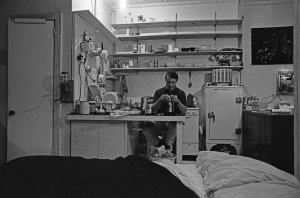
Roy Lichtenstein working on his ceramic sculptures in his kitchen on 26th Street, New York, 1965.
Photograph by Ugo Mulas
© Ugo Mulas Heirs. All rights reserved
June 1 Second solo show at Galerie Sonnabend in Paris. Eisenhauer wears a dress designed by Lee Rudd based on one of his Sunrises for the opening reception.
Fall First Brushstroke painting (1965; private collection) is inspired by an image of a painted brushstroke from a science fiction comic-strip panel. Other invented Brushstroke works follow.
Nov. 20–Dec. 11 Castelli presents the Brushstrokes along with recent ceramic pieces.
Dec. 7–31 Teardrop cloisonné pendant of a crying girl (1965) published in an edition of 6 is shown at Multiples, Inc.
Enameled works feature sunrises and other cartoon-inspired imagery, including first large-scale group of 16-gauge porcelain enamel on steel wall and standing sculptures based on cartoon explosions in various primary colors, which also evidence perforated metal screens.
1966
Dialogue balloons disappear from canvases.
Creates paintings featuring drips and blots of paint against a graph-paper grid background.
Begins to add surplus Hansen motors to the back of his Rowlux seascapes to simulate the waves of an ocean. Adds specially made light fixtures fabricated by Grand Lighting in Brooklyn to others whose painted bulb casings rotate through a spectrum of color gels to simulate different times of day. Many light fixtures are later removed and discarded because of breakage and the difficulties in running them.
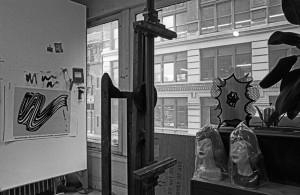
Studio at 26th Street, New York, 1965.
Photograph by Ugo Mulas
© Ugo Mulas Heirs. All rights reserved
Feb. Contributes work to Los Angeles Peace Tower, a monument designed by Mark di Suvero.
Mar. 6–Apr. 2 In Caracas, Venezuela, promoting Jacinto Quirarte’s show Pop Art: La Nueva Imagen, sponsored by Tabacalera Nacional/Philip Morris International.
Apr. 15 On Pop art symposium panel with Larry Rivers and Frank Stella, sponsored by the San Francisco Art Institute.
Apr. 27 Gala opening of the fifth annual exhibition and sale to benefit the Congress of Racial Equality (CORE) at Grippi & Waddell Gallery, New York, which includes his limited-edition button featuring an apple core inside a painter’s palette.
Summer Designs a limited-edition deluxe print on silver foil (1966; edition of 100) along with a larger commercial run of posters, based on 1930s Hollywood motifs, for Lincoln Center’s fourth New York Film Festival.
June 18–Oct. 16 Together with Helen Frankenthaler, Kelly and Jules Olitski, represents the United States at the 33rd Venice Biennale in an exhibition organized by Henry Geldzahler. Travels to Venice for the opening.
Oct. 1 Six-piece table setting of signed black-and-white china pieces produced by Jackson China Co. for Durable Dish Company sold at Leo Castelli.
Nov. 4–Dec. 1 The Cleveland Museum of Art presents first solo museum exhibition, Works by Roy Lichtenstein, organized by Ed Henning.
Mulas’s images of the artist appear in Alan Solomon’s book New York: The New Art Scene.
Interviewed by British art critic David Sylvester for a broadcast of the BBC’s Third Programme.
Moves to 190 Bowery at Spring Street. Sets up a residence and studio on the fourth floor of the former German bank built in 1917. The studio is better lit, thanks to two large walls of windows that look out onto the Bowery. Adolph Gottlieb lives on the second floor, and Malcolm Morley, Louise Nevelson and Mark Rothko live in the neighborhood. Paul Potash assists at the studio one day a week and learns how to construct the floor-to-ceiling easels.
Hires Jerry Simon as assistant.
The Tate Gallery, London, purchases Whaam!
1967
The Modern series emphasizes double-density dots more than in the lips or eyes of Pop-based work, where dots touch tangentially to create a white star in the middle.
Mar. 23 Divorce from Isabel is finalized.

Studio at 190 Bowery, New York, 1967.
Photograph by Ugo Mulas
© Ugo Mulas Heirs. All rights reserved
Apr. “How an Elvis Presley Becomes a Roy Lichtenstein” by Salvador Dalí appears in Arts Magazine.
Apr. 13 Temple of Apollo Billboard is unveiled at the corner of Melrose and La Cienega Boulevards in Los Angeles, announcing a show at the Pasadena Art Museum. The billboard is one of five donated to the museum by the advertising firm Foster and Kleiser.
Apr. 18–May 28 The Pasadena Art Museum, in collaboration with the Walker Art Center, Minneapolis, presents first traveling retrospective, organized by Coplans. The first solo exhibition catalogue is published.
Commissions Beckley to make a metal screen with graduated dots for use in his mural for Expo ’67.
Apr. 28–Oct. 29 Mural Modern Painting for Expo ’67 (1967; Norton Simon Museum, Pasadena) in American Painting Now at the Expo ’67 US Pavilion in Montreal, which features graduated Benday dots.
Summer Rents Rivers’s house in Southampton, New York, with friends.
Works with Hollander Workshop in New York to produce his lithograph Explosion (1967; edition of 100) for Portfolio 9.
Aug. 17–20 Artist-in-residence under the auspices of the Aspen Center for Contemporary Art, along with Allan D’Arcangelo, Les Levine, Robert Morris, Oldenburg and DeWain Valentine. They conceive of a weeklong “Culture-In” series of events that includes a black-and-white taped and painted environment entitled Room in studio space on the second floor of the Brand Building at the corner of Galena and Hopkins Streets. The installation is meant for destruction, although a door with the words “Nok!! Nok!!” (1967; private collection) is dismantled and saved with the artist’s permission.
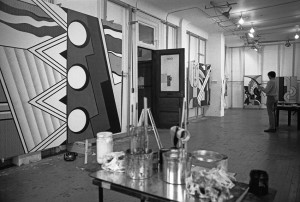
In his studio at 190 Bowery, New York, 1967.
Photograph by Ugo Mulas
© Ugo Mulas Heirs. All rights reserved
Fall Collaborates with Guild Hall in Paramus, New Jersey, to fabricate sculptures made of brass, mirror, tinted glass, marble, aluminum and wood.
Billboard Super Sunset is installed on Sabol’s handball court in Villanova, Pennsylvania. Covering six plywood panels and painted by hand, it measures 11 by 28 feet, but is later destroyed.
Sept. Submits Illustration for “Romanze, or The Music Students” (I) and (II) for In Memory of My Feelings: A Selection of Poems by Frank O’Hara, an unbound book (2,500 numbered on colophon page) of two musically derived Modern images drawn on a plastic surface. Edited by Bill Berkson, the works are done in honor of O’Hara, an assistant curator at MoMA who had died tragically.
Nov. 4–Dec. 17 The Stedelijk Museum presents first European retrospective. The show travels to three other museums, including the Tate in 1968. It is the Tate’s first show dedicated to a living American artist.
Appointed Regents Professor, University of California, Irvine.
Begins first Stretcher Frame paintings.
1968
Jan. Hires Carlene Meeker as assistant. Her first task is to scrape off the dots incorrectly applied by one of his former assistants and repaints them; she stays on for twelve years. Often works on fifteen to twenty paintings at a time.
Jan. 4 Arrives in London for opening of Tate retrospective. Travels to Morocco with family after opening festivities.
Makes first Modular paintings featuring repeated design imagery, inspired by an art project completed in third or fourth grade.
May 24 Commissioned image of Robert F. Kennedy appears on cover of Time magazine.
June Invited by Los Angeles County Museum of Art (LACMA) curator Maurice Tuchman to participate in forthcoming Art and Technology exhibition. Is paired with Universal Studios in Los Angeles.
Creates Modern Head Pendant, an enamel brooch in an edition of 250, which is sold by Multiples, Inc.
June 21 Time magazine features his rendering of a gun for its cover story, “The Gun in America.”
Summer Visits the Pasadena Art Museum with Coplans and sees Constructivist paintings of heads by German Expressionist artist Alexei Jawlensky. Coplans discusses his ideas for an exhibition on serial paintings. Creates first paintings on the theme of Claude Monet’s Haystacks. Continues making works featuring Art Deco and stretcher bar imagery.
Shares house on Wooley Street in Southampton with friends.
Aug. Paper boat Hat (1968; edition of approximately 2,000) is included in S.M.S., issue 4, a portfolio of artists’ works edited by William Copley and Dimitri Petrov.
Sept. Joins artists’ boycott of Chicago museums over the police action during the Democratic National Convention.
Sept. 10 Appointed Fellow for Life at the Metropolitan Museum of Art.
Sept. 12 Tours Universal City Studios.
Sept. 17–Oct. 27 Sees Coplans’s exhibition Serial Imagery at the Pasadena Art Museum. Begins series of Rouen Cathedrals.
Oct. 22–Nov. 23 Charles E. Slatkin Inc. Galleries debuts wool tapestry fabricated by modern masters, featuring a Modern version of a classical Greek head.
Oct. 23 Invited by prominent Chicago dealer Richard Feigen to contribute a work to monthlong protest exhibition Richard J. Daley.
Nov. 1 Marries Herzka.
Nov. 24 Commissioned to make movie poster for Joanna (1968; edition unknown); it is reproduced in black-and-white newspaper ads but never distributed.
Commissioned to create an editioned sculpture to commemorate the fiftieth anniversary of both the US Postal Service and international airmail service, Salute to Airmail (1968; edition of 50 each in silver, gold-plated bronze and chromium-plated copper).
Designs Wrapping Paper sold at On 1st; Paper Plate sold following year is one of first to use the reflective motif.
Executes several studies for New York State Mural (Town and Country) (1968), an unrealized mural for the New York State Legislature Building commissioned by the Empire State Plaza Art Commission.
Richard Kalina begins as studio assistant.
1969
Winter/Spring Abandons metal screens and begins to use red oilboard perforated sheets he orders from Beckley, which are easier to manipulate. Haystack and Rouen Cathedral canvases are aided by assistants who must meticulously cut out wax paper stencils using a single-edge razor blade and lay them onto the canvases with double-sided tape. Directs the dotting process, which is painstaking. Next, a brayer is used to apply paint. Then applies a standard three coats of Magna paint, the black, to finish up a line, working from thin to thick. If unhappy with the result, can wipe away the Magna with turpentine, since the alcohol-based varnish protects the layer underneath, which allows for a very flexible system.
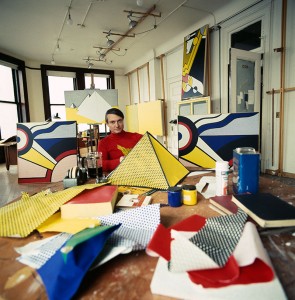
Roy Lichtenstein in his studio at 190 Bowery, New York, 1969.
Photograph by Lord Snowdon/Trunk Archive
Jan.–July Issues first serial prints (seven Haystack and six Rouen Cathedral lithographs) through Gemini G.E.L. in Los Angeles, collaborating with master printer Kenneth Tyler.
Kalina leaves, and Richard Dimmler begins as studio assistant.
Feb. 3 Returns for a two-week stay at Universal City Studios, after which decides to make “moving pictures.” Sketches fifteen landscape pictures in total, which would combine filmed sequences with other synthetic material separated by a heavy black horizontal line that would rock back and forth.
Photographed by Lord Snowdon in his Bowery studio with Pyramid paintings and several Modern works; photographs appear in Vogue magazine in September.
Summer Stays on Wooley Street in Southampton again with friends. With the assistance of filmmaker Joel L. Freedman of Cinnamon Productions Inc., shoots 35 mm film of the sunrise and sunset in Montauk using a high-powered telescope attached to a Bolex camera. The resulting footage is too shaky to use. Over the course of the year, they experiment with shooting footage of rippling ocean water under Benday dot props. Not satisfied with the results, plans are altered to create three completely filmed vignettes that mirror the precision and clarity of his paintings. With Freedman, seeks out special-effects expert Hugo Casolaro, who collaborates on animating both the color and imagery of the final product, entitled Three Landscapes.
Fall Creates first Mirror paintings, inspired by the airbrushed quality of mirror sales catalogues. Begins to photograph own source material, such as magnifying mirrors that produce abstract shadows and shapes.
Sept. 23 Buys carriage house on Gin Lane in Southampton.
Sept. 19–Nov. 16 First New York retrospective of paintings and sculptures, at the Solomon R. Guggenheim Museum, organized by Diane Waldman. The show travels to four other US museums.
1970
Mar. 15–Sept. Two landscape films are shown on 7-by-11-foot screens using 35 mm film loop rear-screen projectors at the Expo ’70 US Pavilion in Osaka, Japan. The artist does not travel to Japan to see the installation.
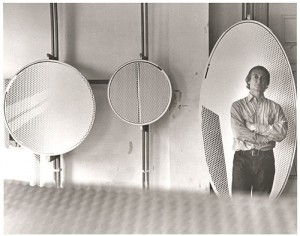
Roy Lichtenstein standing in front of Mirror #1 (6’ x 3’) (1971) in his Southampton studio; also pictured: Mirror #8 (36” diameter) (1971) and Mirror #12 (24” diameter) (1970).
© Renate Ponsold
Summer Moves into Gin Lane house with plans for a studio on the third floor, but ceilings turn out to be substantially lower than expected.
Creates first brass relief in an edition of 100 of a Modern Head (1970) for sale by Gemini G.E.L.
Oct. Signs first realized large Brushstrokes mural—12 by 245 feet on four continuous walls—at the University of Düsseldorf School of Medicine.
Bianchini publishes the first monograph cataloguing most of his drawings and prints.
1971
Begins Entablature series in black and white using own photographs of Wall Street’s neoclassical buildings as sources, which are inspired by the background decorative dividers in works by Cubist painters such as Picasso and Georges Braque.
Mar. 13–Apr. 3 Mirrors exhibited publicly for the first time at Leo Castelli.
May 10–Aug. 29 Three Landscapes (1970–71), which features an additional film loop along with the two shown in Osaka, is shown in 16 mm format in Art and Technology at LACMA. Once again, the artist does not see the final installation.
May 12 Inducted as a fellow into the American Academy of Arts and Sciences (Boston).
Sept. Castelli opens a new gallery at 420 W. Broadway in SoHo.
Designs a poster for UNICEF child welfare programs, Save Our Planet Save Our Water (1971), to raise ecological awareness. It references fish in an aquarium similar to his third and final film loop shown at LACMA.
Lithograph Mao (1971) accompanies Frederic Tuten’s The Adventures of Mao on the Long March. The lithograph is packed in a specially designed container that acts as its frame and includes Tuten’s signed and numbered book on the reverse.
Designs his studio in Southampton across the lawn from the house as a classic saltbox, with skylights. Replicates easel walls of wooden racks and clamps.
Harry N. Abrams publishes first monograph of his paintings and sculpture, written by Waldman. Italian and German editions are also published that same year.
1972
Documentary Monographs in Modern Art publishes monograph edited by John Coplans.
Begins Still Life series.
Increasingly uses diagonal stripes in place of Benday dots.
Begins to quote own work in Still Life paintings.
References to Matisse appear in works.
Oct. Serves as visual consultant to Frank Perry’s film Play It as It Lays, based on a novel by Joan Didion.
James de Pasquale begins as studio assistant in Southampton; Dimmler leaves.
1973
Begins series of trompe-l’oeil and Cubist still lifes, which includes his take on their use of faux-bois, but which also mimics Rowlux.
Channels the work of Morris Louis in a collage and then a painting Untitled (Morris Louis Unfurled) (1973; private collection).
Fall Begins Artist’s Studio series, incorporating self-quotations of early 1960s paintings and drawings. Includes references to abstract-style paintings, precursors to a series of Perfect/Imperfect works.
Creates paintings showing the influence of De Stijl and Russian Constructivism. Picasso’s Bulls become a particular theme in graphic work.
1974
Paints first works influenced by Italian Futurism.
Begins new series of Entablatures using metallic and pastel colors. Mixes sand with paint to highlight surface texture.
Sept. Modern Head, the first large-scale sculpture in metal, wood and polyurethane, is assembled on a site in the Santa Anita Fashion Park in Arcadia, California.
1975
Jan. 10–Feb. 1 Centre Beaubourg in Paris organizes first traveling retrospective of drawings.
Begins series of paintings based on works by Le Corbusier and Amédée Ozenfant.
1976
Paints Office Still Lifes based on newspaper illustrations of office items and business furniture.
Completes final series of Entablature paintings.
Creates several self-portraits in Futurist style.
Warhol creates a silk-screen portrait of him.
Makes first painted sculptures in bronze of mirrors, coffee cups and drinking glasses. Uses the lost wax process, in which rubber molds encased in ceramic are made from his wooden maquettes, and wax is then steamed out and bronze poured into the mold. Bronze is patinated black, and colored areas are created using a brand of polyurethane anti-aircraft paint called Bostic, often in combination with Magna.
Produces bicentennial poster for the American Revolution Bicentennial Administration.
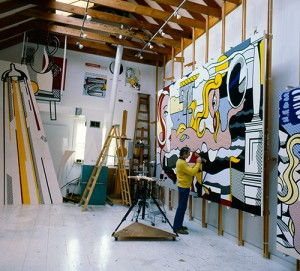
Roy Lichtenstein in his Southampton studio in 1977, photographed by Aurelio Amendola.
© Aurelio Amendola
1977
Begins series of paintings based on works by Surrealist artists (including Dalí, Max Ernst and Miró) and Surrealist works by Picasso, some featuring a dialogue balloon.
Olivia Motch is administrative assistant.
Mar. Commissioned by BMW to create an exterior design for their 3201 race car, driven later in the year at Le Mans. They send a plastic mold, which he returns in April with a design of a sunrise.
Apr. 26 Receives Skowhegan Medal for Painting and Sculpture.
May 13 Is awarded doctorate in fine arts from California Institute of the Arts in Valencia.
1978
Jan. 12 Stage prop of an airplane (1978; private collection), made from Magna and tape on foam core mounted on wood, for American poet Kenneth Koch’s novel-turned-play The Red Robins (1975) debuts at Saint Clement’s Church on W. 46th Street. Made from tape, Magic Marker and collaged elements, a replica by artist Vanessa James is used in the show to avoid wear and tear.
North American Indian motifs reappear.
June 5 First large-scale outdoor sculpture, Lamp (1978; private collection), in welded painted bronze with painted brass light rays fabricated by Tallix, is commissioned by Gilman Paper Company, St. Mary’s, Georgia, and installed in front of its main administrative building (later deinstalled).
July 19–Sept. 24 Contributes cover design for the Whitney Museum of American Art’s exhibition Art about Art, organized by Jean Lipman and Richard Marshall.
Visits Los Angeles. Sees the Robert Gore Rifkind collection of German Expressionist graphic art.
Nov. 12–26 Invited by Anand Sarabhai to visit his home in Ahmedabad, India, designed by Le Corbusier for Anand’s mother, Manorama Sarabhai. There, makes several textile works on canvas and Mirrors in sandstone and marble. Prepares teakwood blocks for Goldfish Bowl, Lamp and Picture and Pitcher (each in editions of 30) but is unable to print them because blocks are warped. Prints them the following spring after Tyler Graphics fixes them.
1979
Makes last Surrealist-inspired works.
Begins German Expressionist–inspired works based on paintings and woodcuts by artists such as Erich Heckel, Franz Marc and Karl Schmidt-Rottluff.
May Awarded honorary doctorate in fine arts from Southampton College in New York.
May 23 Elected to the National Institute of Arts and Letters (elevated in 1993 to the American Academy of Arts and Sciences, New York).
July First outdoor public sculpture commission, Mermaid (1979; Miami Beach Theater for the Performing Arts), is installed. The 24-foot-high painted steel work fabricated by Tallix is poised on three concrete waves in a fountain pool. A live palm tree planted near the head of the sculpture completes the ensemble.
July 11 London premiere of BBC profile re-creates Bowery studio, and films him at work in the Southampton studio.
Oct. 25 Designs Untitled Shirt using mirror motif in an edition of 150 in collaboration with the Fabric Workshop, Philadelphia, for Artist Space’s sixth-anniversary fund-raising party at the Mudd Club.
1980
Makes numerous Expressionist Heads in sculpture and on canvas, along with Expressionist-inspired Nudes in Landscape paintings.
Combines loosely painted brushstrokes with constructed Abstract Expressionist brushstrokes in series of single and grouped apple drawings and several canvases based on the conceit of cartoon-style brushwork.
Creates an American Flag canvas, which he later destroys.
May Sketches some designs for a tea set commissioned by Rosenthal Glas und Porzellan AG; the edition of 100 is completed in late 1984.
Sept. 25 Isabel Lichtenstein (1921–80) dies.
1981
May 8–June 28 Exhibition of paintings and sculptures from the period 1970–80 at Saint Louis Art Museum, organized by Jack Cowart; the show travels to museums in the United States, Europe and Japan.
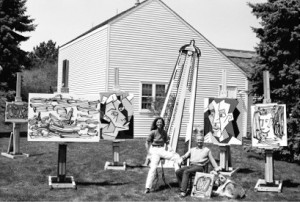
Roy Lichtenstein with Dorothy Lichtenstein outside his Southampton studio, ca. 1981.
Photograph by Arthur Schatz
Oct. 4–Nov. 25 The Whitney Museum’s downtown branch on Wall Street showcases graphic work from the period 1971–81.
Oct. 17–Nov. 7 Leo Castelli presents new works, featuring renditions of apples on canvas.
Painting a small sketch on acetate projected onto canvas, creates four Woman paintings using modified Abstract Expressionist brushstrokes based on Willem de Kooning’s third Woman series from the late 1950s. Other subjects include apples, sailboats and forest scenes. Before Magna is applied, uses collaged cutouts of painted brushstrokes to determine the final composition and palette.
1982
Jan.–Feb. Travels to Egypt.
Apr. 1 Participates in roundtable discussion for exhibition Roy Lichtenstein at Colorado State University, April 1–30.
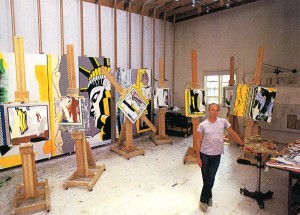
Roy Lichtenstein in his Southampton studio, ca. 1982.
Photograph by Kan Okano
June Submits three-dimensional maquette for tallest sculpture to date, Brushstrokes in Flight, to a national competition sponsored by the City of Columbus for an international airport.
Sets up studio at 105 E. 29th Street between Lexington and Park Avenues, next to the Hotel Deauville, on the seventh floor.
Begins series of paintings incorporating a frame motif, and Paintings and Two Paintings series, in which two contrasting images are ambiguously linked by a single or hybrid frame motif. Reference to Johns’s flagstones appears in one canvas.
Aug. 8–Sept. 19 Look Mickey, Popeye (1961; private collection) and Wimpy (Tweet) (1961; private collection) are exhibited for the first time at the Parrish Art Museum in Southampton.
1983
Winter Petersburg Press publishes Seven Apples, a series of seven-color woodcuts in an edition of 60 each.
Mar. Selected to design, execute and install Brushstrokes in Flight (1984; Collection of the Columbus Regional Airport Authority) near the central courtyard at the airport entrance. In June 1985, it is moved indoors for better visibility.
Mar. 21 Poster for UN Special Committee Against Apartheid is published by Galerie Maeght-Lelong in Paris.
Oct. 4–Dec. 4 Contributes design to Brooklyn Academy of Music Next Wave Festival.
Publication of monograph by Alloway. Includes “Notes on Technique.”
Nov. Begins 96-foot-long mural on the wall of Castelli’s Greene Street gallery space, a compilation of many motifs including those from earlier works. Robert McKeever works on Greene Street Mural and eventually becomes part-time studio assistant in New York. The painted and collaged mural is only meant to exist from the time it opens to the public on December 3 until January 14, 1984, when it is covered over with sheet rock. The mural is fully destroyed when Castelli closes the gallery space in the fall of 1988.
Designs logo for the Visual Arts Center at OSU, a yellow brushstroke on a blue grid background.
1984
Returns to New York part-time to live and work on E. 29th Street. The east wall has a Formica surface that he can draw on or tape things to, and it has windows along the north and south. Big paintings are difficult to fit in the elevator. Paints an image of Swiss cheese on elevator doors. McKeever works part time as studio assistant until the end of 1985 and thereafter full time.
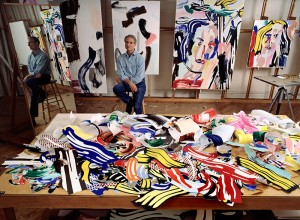
Roy Lichtenstein in his studio on East 29th Street with Face in Forest and Blonde (both 1986).
Thomas Hoepker/Magnum Photos
Spring Joins board of directors of the Studio in a School Association, a not-for-profit organization that brings art experiences and artists to New York City public elementary schools.
May 3 Commissioned to create a mural for the lobby of the Equitable Tower (now AXA Equitable Center) in midtown Manhattan. The skyscraper, designed by Edward Larrabee Barnes and developed by Tishman Speyer Properties, is completed in early 1986 and features a five-story skylit atrium. In December, submits maquette for Mural with Blue Brushstroke (1984–86) out of preparatory drawings collaged together.
Sept. Castelli arranges the commission for a large-scale outdoor sculpture for the Walker Art Center.
Sept. 20–Dec. 2 The Whitney Museum presents Blam! The Explosion of Pop, Minimalism, and Performance, organized by Barbara Haskell.
1985
May 31 Contributes a new print of the American flag (1985; edition of 125) for the Institute of Contemporary Art at the University of Pennsylvania fund-raising event called “Round the Flag.”
Nov. 21 Sketching for Mural with Blue Brushstroke begins on the wall of the Equitable Tower, and painting begins December 7.
Sketches out a logo on a cocktail napkin for the Hampton Jitney Company for their “Riding the Wave” campaign. Logo appears on its buses beginning in 1989.
First Perfect painting bearing the title (1985; Kunsthalle Weishaupt, Ulm, Germany).
In his studio on 29th Street creates the first of several American flaglike compositions from diagonals and Benday dots called Forms in Space in a variety of media.
1986
Jan. Mural with Blue Brushstroke completed. References to Léger, Matisse, Stella, Johns, Entablatures and early Pop imagery as well as other art-historical motifs feature prominently in the final design.
Feb. 15 Made from painted and fabricated aluminum and standing over 25 feet high, Salute to Painting (1986; Walker Art Center, Minneapolis) is dedicated at the Walker Art Center.
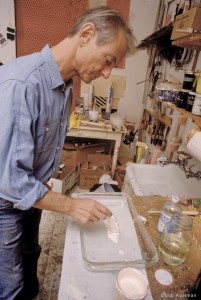
Roy Lichtenstein at his studio in Southampton, New York, ca. 1986.
© Bob Adelman
Spring Imperfect paintings, featuring compositions of generic geometric abstraction that feature a single line that bounces from one edge of the canvas to the other, sometimes breaking the boundary of the canvas.
Approached by Taittinger to design a bottle for their champagne. Result is introduced on October 16, 1990, in Paris. Some one thousand wine glasses with the same image are distributed with the bottle.
Tyler Graphics Ltd., now located in Mount Kisco, New York, publishes a series of hand-painted Brushstroke wall relief sculptures in cherry wood (1986; each in an edition of 10).
Dec. 12 Begins work for the first time with Donald Saff, founder of Graphicstudio, located at the University of South Florida in Tampa, to publish two versions of his Brushstroke Chair and Ottoman, one in white birch veneer crafted by Beeken Parsons in Shelburne, Vermont (1986, completed November 10, 1988; edition of 16), and another in bronze from the Walla Walla Foundry in Washington state (1986, completed June 30, 1988; edition of 5).
1987
Feb. At Gemini where he begins work on Imperfect prints where edges extend over the conventional print border. The prints are published the following year, each in an edition of 45.
Feb. 2–Mar. 5 Works with Graphicstudio to produce a series of Waxtype prints featuring Brushstroke Faces (1989; each in an edition of 60) that utilize beeswax instead of printer’s ink to create an encaustic finish.
Mar. 15–June 2 MoMA mounts a major drawings retrospective, organized by Bernice Rose, the first show of drawings by a living artist ever presented by the museum. The show travels to museums in the United States and Europe.
July Peter Littmann, Executive Director of Vorwerk & Co. Teppichwerke in Hameln, Germany, visits the artist to commission a design for a commercial wall-to-wall unlimited edition nylon carpet using no more than six colors and measuring four meters in width. Other artists commissioned include Sol LeWitt, Arata Isozaki, David Hockney, Jean Nouvel, Sam Francis, Zaha Hadid, Mimmo Paladino, Michael Graves and Richard Meier. Designs are submitted the following March.
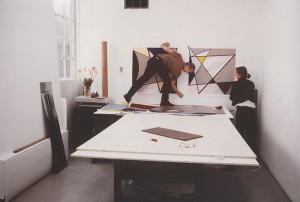
Roy Lichtenstein assisted by Diana Kingsley in the Gemini G.E.L. Artists Studio, working on his Imperfect print series, February 1987.
Photograph by Sidney Felsen © 1987
Summer Designs the exterior of a mirrored glass labyrinth funhouse for André Heller’s traveling amusement park Luna Luna in Hamburg, with piped-in music by Philip Glass.
Nov. Visits Israel for the first time for opening of drawings show at the Tel Aviv Museum of Art. Discusses the possibility of a permanent mural for the museum with director Marc Scheps.
Creates diptychs Painting with Detail (Blue) (1987; private collection) and Painting with Detail (Black) (1987; Robert and Jane Meyerhoff Collection), in which a full field of blue and black Benday dots, respectively, appear alongside a much smaller counterpart.
A committee for the Lichtenstein Museum is inaugurated in St. Louis in the hope of renovating mansions in Oak Knoll Park in Clayton, Missouri, as a research and study center along with galleries that would feature changing exhibitions of varying themes related to the artist and his time. The project is never developed.
1988
Begins Reflections series in Southampton, incorporating quotations of both previously depicted and new comic strips, a motif not fully used since the 1960s. Comes upon the idea while trying to photograph a Rauschenberg print under glass.
Creates sculptures of heads in patinated bronze on the themes of the archaic and the surreal and those of Constantin Brancusi.
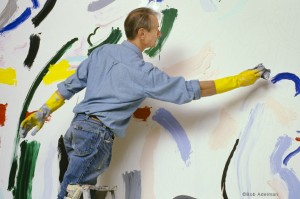
Roy Lichtenstein laying in color on
10 x 15-foot painting Forest Scene with Temple (1986).
© Bob Adelman
Returns to the idea of creating drawings in black and white.
Coups de Pinceau (1988; Caisse des Dépôts, Paris), a 31-foot-high aluminum Brushstroke sculpture, is installed at the Caisse des Dépôts et Consignations in Paris.
First German-language monograph devoted to pre-Pop works is written by Ernst A. Busche.
Begins Plus and Minus series based on works by Mondrian.
Sketches curtain design for André Heller’s staging of Body and Soul (1988), a musical revival of the music, dance and spirituals of the thirties and forties. His curtain is used as the backdrop for the tour in the United States and Europe.
Sketchbook contains first image of a Virtual motif.
Commissioned to design a poster for the California campaign of Democratic presidential candidate Michael Dukakis. A black border added by the campaign is not part of the original design.
Spring Patricia Koch replaces Motch as administrative assistant.
May Sets up a studio and residence in a 1912 building at 745 Washington Street. A former steel fabricating business, it is renovated by architect David Piscuskas of the firm 1100 Architect. Constructs his wooden easel walls around the perimeter. Divides time between Southampton and Manhattan.
June Receives honorary doctorate in humanities from OSU.
Nov. 16–May 1989 Brushstroke Group (1987; private collection), a 30-foot-high painted aluminum sculpture, is installed in Central Park’s Doris C. Freedman Plaza in Manhattan as part of the Public Art Fund’s project to install temporary installations on public sites in New York.
Designs second shopping bag, produced by Dayton Hudson Department Store Company, to celebrate the inauguration of the Minneapolis Sculpture Garden in cooperation with the Walker Art Center and the Minneapolis Park and Recreation Board. The bag features Brushstrokes on a field of Plus and Minus imagery.
1989
Mar. 15–May 15 Artist-in-residence at the American Academy in Rome. Sees highway sign advertising furniture, which spurs him to look through the Rome yellow pages for similar imagery. Begins thinking about doing a series of Interiors based on findings.
Apr. 8–14 Travels with studio assistants to Tel Aviv to begin work on a large mural for the entrance hall of the Tel Aviv Museum of Art. Signs the completed mural on May 7.
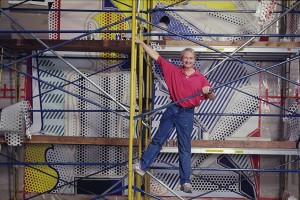
Roy Lichtenstein on scaffold at the CAA building in Beverly Hills, CA, painting Bauhaus Stairway Mural, 1989.
© Alan Levenson
Summer Begins work on Bauhaus Stairway: The Large Version, a mural for a building designed by I. M. Pei for Creative Artists Agency in Beverly Hills and commissioned by collector and agency founder Michael Ovitz.
June Commissioned by the Metropolitan Transportation Authority of the State of New York (MTA) to create Times Square Mural (1990, fabricated 1994; MTA, New York) at the subway station at 42nd Street and Times Square. Plan is scrapped, but decides to fabricate the sixteen panels of porcelain enamel on steel. In 2002 they are posthumously installed by Polich ArtWorks for the MTA Arts for Transit program. They feature science fiction themes in a Buck Rogers futuristic style similar in feel to the 1964 Art in America panorama cover illustration and the 1965 print This Must Be the Place.
Oct. Begins joint project with Philip Glass on a hand-cast bronze, copper and wood music box, Modern Love Waltz (1991; only eight completed). The piece is fabricated by Peter Carlson Enterprises in Sun Valley, California, and issued by The Object of Art by Grinstein/Donenfeld Ltd. Edition Fine Art Objects in December of 1991.
Continues to create Reflections which feature numerous Untitled abstractions as well more figurative ones where Wonder Woman, Dagwood, Donald Duck and Nancy—in homage to Warhol’s early painting of the comic heroine—are featured in the composition. Tyler Graphics begins work on nine prints in the series, each in an edition of 68, which are published the following year.
Time magazine reissues his image of Bobby Kennedy and The Gun in America as prints, each done only in an edition of 2 and given to the National Portrait Gallery in Washington, D.C., where they joined the original drawings and overlays used to produce the covers.
First colored pencil drawing of an Interior.
Fall Discussions with Gemini about creating a print series of Interiors. One work features a portrait of Mao which references both his early work and Warhol’s. Another features Dagwood Bumstead’s living room (1990; each in an edition of 60).
First Mobile in painted and patinated bronze fabricated by Tallix. Four others are produced the following year, each in an edition of 12, and another bronze Landscape Mobile is produced in 1991, in an edition of 6.
1990
Winter Begins Interiors series, whose drawings are predominantly executed on polyester tracing film. Paints for the first time with sponges to create faux texture. Many feature paintings hanging on walls that the artist wanted to try out but not paint as full-fledged works. Uses the conceit of a room corner in most compositions.
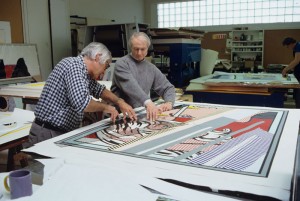
Kenneth Tyler and Roy Lichtenstein cutting silver metalised PVC plastic film for Reflections on conversation from the Reflections series, Tyler Graphics Ltd., Mount Kisco, New York, 1990.
National Gallery of Australia, Canberra
Gift of Kenneth Tyler, 2002
Photograph by Marabeth Cohen-Tyler
Jan. Commissioned by composer Steve Reich to create a cover design for recording called The Four Sections. The cover and accompanying promotional poster are published by Elektra Entertainment, New York, the following year.
Sherrie Levine appropriates several of his comic-strip paintings and prints in her 1990 mixed-media work Collage/Cartoon.
Summer Laurie Lambrecht begins to work part time in New York and Southampton, replacing Koch.
June Works again with Saff at his new shop Saff Tech in Oxford, Maryland, to create a bas-relief, Suspended Mobile (1990; edition of 19), and Water Lily prints based on Monet’s late Water Lilies. Creates six in enamel (1992; each in an edition of 23) which feature a handmade swirling design on metal developed by Saff using a rubber drill bit. Designs individual wood frames for several of the enamel prints.
Sept. Cassandra Lozano joins the New York studio full time, and Lambrecht begins to work in the summers only, until 1992.
Oct. 7–Jan. 15, 1991 Some comic-book sources are researched and shown for the first time in MoMA’s High and Low: Modern Art and Popular Culture, an exhibition of twentieth-century art that includes source materials and related ephemera.
Creates costume designs for André Heller’s unrealized Pyramid Opera, which was to star soprano Jessye Norman. The headdress is later made and worn by Maria Bill for Heller’s opera Sein und Schein, which debuts in Salzburg, Vienna, at the Burgtheater on January 19, 1993. Also participating in the opera project are Mimmo Paladino, Keith Haring and Andy Warhol.
Tallix produces two Mobiles in painted and patinated bronze as well as a new version of an Airplane (1990; edition of 6), an outdoor piece in bronze.
Artes Magnus in New York publishes a porcelain-and-cast-resin Landscape Mobile produced by Bernardaud in Limoges, France (1990; edition of 125).
Produces a print of a Mirror (1990; edition of 250) with Gemini for the benefit of the Harvey Gantt for Senate Campaign.
1991
Apr. 2–June 16 Two Interior paintings are included in Whitney Museum’s Biennale.
Apr. 25 Receives Brandeis University’s Creative Arts Award.
May 15–Oct. 31 Modern Head (1974/1989; Smithsonian American Art Museum, Washington, D.C.), based on a 1974 metal, wood and polyurethane sculpture at the Santa Anita Fashion Park in Arcadia, California, is installed in Battery Park City in Lower Manhattan. The work is later recovered after the September 11, 2001, attacks on the World Trade Center.
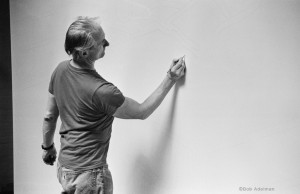
Roy Lichtenstein drawing on canvas in his studio, ca. 1991.
© Bob Adelman
Fall In collaboration with Saff Tech Arts begins making enamel prints (on stainless steel with wooden frames) based on Monet’s late Water Lilies.
Oct. Creates a sculpture based on the image of an African mask in Interior with African Mask (1991; The Eli and Edythe L. Broad Collection, Los Angeles). It is fabricated at Tallix in versions of galvanized steel, tin-plated bronze, zinc-plated bronze and pewter, each in editions of 6.
Creates ten collage studies for screen prints to be illustrated in Nouvelle chute de l’Amérique, a limited-edition unbound book published in 1992 by Les Éditions du Solstice to accompany eleven Allen Ginsberg poems under the title Fall of America. Etchings and aquatints are pulled on a handpress at Atelier Dupont in Visat, Paris. Each edition is signed and numbered by both.
Creates landscape mobiles in porcelain and cast resin with Tallix (edition of 6).
1992
June Approached by dealer Ronald Feldman to help fund-raise on behalf of the Democratic National Committee and Democratic senatorial campaigns. Creates a print of the Oval Office to benefit ten female senatorial candidates. A poster is also created.
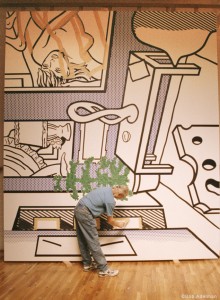
Roy Lichtenstein looking at his painting, Interior with Bonsai Tree (1991) in his Washington Street studio, ca. 1991.
© Bob Adelman
June 12 Made Commandeur de l’Ordre des Arts et des Lettres by the French Republic.
July Inspired by the work of Catalan artist Antoni Gaudí, creates Barcelona Head (1992; Ajuntament de Barcelona), a 64-foot-high sculpture made of colored ceramic tiles, commissioned for the summer Olympics in Barcelona, Spain. It is installed on the site of the former naval yard where Christopher Columbus docked his ships.
Creates an interior inspired by Vincent van Gogh’s The Bedroom (1889; the Art Institute of Chicago).
Dec. 6–Mar. 7 The Museum of Contemporary Art, Los Angeles, presents Hand-Painted Pop: American Art in Transition, 1955–62, organized by Paul Schimmel and Donna De Salvo, devoted exclusively to the early years of the Pop art movement in the United States. Pre-1960s works such as Washington Crossing the Delaware I (c. 1951; The Roy Lichtenstein Foundation Collection) and several semiabstract drawings of cartoon characters from 1958 are included. The show travels to two other US museums.
His print Rain Forest (1992; edition of 100) initiated by Artists United for Nature is included in the portfolio Columbus: In Search of a New Tomorrow to raise awareness and funds to protect the world’s tropical rainforests. It features his sponging technique.
1993
Jan. Painting Oval Office (1993; Roy Lichtenstein Foundation Collection) is finished.
Spring Begins a series featuring comic-book females in the nude inspired by Picasso’s 1928 beach series. Graduated dots represent chiaroscuro.
Apr. Begins work with Saff Tech on painted nickel-plated bronze Metallic Brushstroke Head (1994; edition of 6).
May Produces cover and frontispiece for Tuten’s book, Tintin in the New World: A Romance (William Morrow), which features Tintin, a character created by Belgian artist Hergé.
July 9 Receives honorary doctorate from the Royal College of Art, London.
July–Aug. Creates Large Interior with Three Reflections (1993; private collection), a mural consisting of a 30-foot-long triptych and three additional panels, for the Revlon Corporation in New York.
Oct. Completes Brushstroke Nude (1993; edition of 3), a 12-foot-high painted aluminum sculpture fabricated at Tallix.
Oct. 8–Jan. 16, 1994 The Solomon R. Guggenheim Museum presents Roy Lichtenstein, a retrospective survey of paintings and sculpture. Designs cover for museum’s magazine. The exhibition travels to the Museum of Contemporary Art, Los Angeles; and the Museé des beaux-arts, Montreal; pre-Pop works are added to the venues at the Haus der Kunst, Munich; Deichtorhallen, Hamburg; and the Palais des Beaux-Arts, Brussels. The tour concludes with a smaller exhibition at the Wexner Center for the Arts, Ohio.
Oct. 23–Nov. 27 New series of paintings, including one of Tintin, premieres at Leo Castelli.
Dec. 23 Receives Amici de Barcelona award from Mayor Pasqual Maragall, L’Alcalde de Barcelona.
1994
Jan. Roy Lichtenstein: The Artist at Work (Lodestar) by Lou Ann Walker is published. Designed to teach children eight to twelve years old about art, it includes photos by Michael Abramson of the artist at work in his studio.
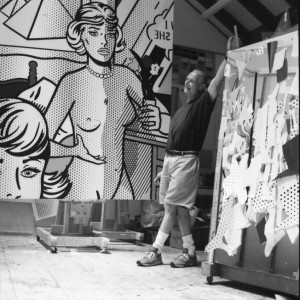
Roy Lichtenstein in his Southampton studio, 1994.
National Gallery of Australia, Canberra
Gift of Kenneth Tyler, 2002
Photograph by Marabeth Cohen-Tyler
Feb. Meets with Tyler at his shop to begin work on Nude prints (1994; each in an edition of 60).
May Unveils designs for the hull and sails for PACT 95’s yacht, Young America, featuring an image of a mermaid on the hull.
Aug. Using machined aluminum, paint and wax, Saff Tech starts fabrication of his relief Woman Contemplating Yellow Cup (1995; edition of 6). That October they begin production on an Imperfect sculpture (1995; edition of 6) using stained cast iron and painted stainless steel plates.
Oct. The Prints of Roy Lichtenstein: A Catalogue Raisonné (Hudson Hills Press, in association with the National Gallery of Art, Washington) by Mary Lee Corlett is published. The book appears in conjunction with the prints retrospective at the National Gallery of Art. The show later travels to LACMA and the Dallas Museum of Art.
Nov. 19–Dec. 17 First series of Nudes is shown at Leo Castelli.
1995
Jan.–Mar. 1996 Works with Gemini on prints showcasing a variety of images including venetian blinds, musical scales and Chinese Style Landscapes.
The Walt Disney Company publishes Virtual Interior: Portrait of a Duck (1995; edition of 60) to benefit several children’s charities. It is his first collaboration with the printing house Noblet Serigraphie, Inc., New York.
Continues to create Interiors, some of which he refers to as “virtual paintings,” which feature colored, instead of black-only, outlining.
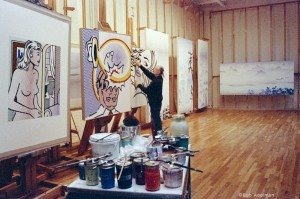
Roy Lichtenstein working on Seductive Girl (1996) in his Washington Street studio, ca. 1996. Also pictured: Coup de chapeau, Landscape with Bridge and Landscape with Philosopher (all 1996).
© Bob Adelman
Mar. 31 The New York Times publishes “At the Met with: Roy Lichtenstein,” an interview conducted by chief staff art critic Michael Kimmelman on the artist’s favorite pieces at the museum.
June 8 Donates Composition III (1995; edition of 186), based on the motif of musical notes, to the Friends of Art and Preservation in Embassies; 175 copies of the print hang in US embassies.
Oct. Selected by Capuchin monks to design and execute two murals for Chapel of the Eucharist, the Padre Pio Pilgrimage located in San Giovanni Rotondo in Apulia, which is to be designed by Renzo Piano. The site centers on the tomb of Saint Pio of Pietrelcina, a Capuchin friar, priest and mystic, and is the second most-visited Roman Catholic shrine in the world.
Oct. 5 Receives the National Medal of Arts at a gala ceremony in Washington, D.C., presented by President and Mrs. Clinton.
Nov. Brushstroke Still Life with Lamp (1997; edition of 24) print on honey-comb core aluminum is started at Saff Tech. It, along with three others, features hand-painted brushstrokes; only one of the four prints is completed by the artist before his death.
Nov. 10 Receives Kyoto Prize from Inamori Foundation, Kyoto, Japan. Travels to Kyoto to accept the award and deliver a lecture on his work.
Inspired by monotype and pastel landscapes of Edgar Degas at the Metropolitan Museum of Art in 1994, begins a large series of Song Dynasty–inspired mountain views that he refers to as Landscapes in the Chinese Style. First makes a series of sketches and creates collages using shapes cut from sheets of printed Benday dot paper in graduated sizes to create monochromatic tonalities that simulate atmospheric effects.
Creates self-portrait, entitled Coup de chapeau (Self-Portrait) (1996; private collection).
1996
May Creates a foam core maquette and a collage for a hologram of a domestic interior commissioned by the C-Project based in Miami Beach. Unhappy with the results, abandons the idea. Concurrently begins work on maquettes of sculptures of a Pyramid and several Houses that rely on inverted angles to create the illusion of three-dimensionality.
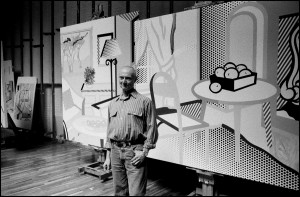
Roy Lichtenstein in his Washington Street studio with Interior with Painting of Trees and Interior with Box of Yellow Apples (both 1997).
Photograph by Inge Morath © Inge Morath Foundation/Magnum Photos.
May 19 Awarded honorary doctorate in fine arts from the George Washington University in Washington, D.C.
Aug. Designs logo for DreamWorks Records, a subsidiary of the film company DreamWorks SKG, founded by David Geffen, Steven Spielberg and Jeffrey Katzenberg. It features a musical note within a dialogue balloon.
Sept. 21–Oct. 26 Roy Lichtenstein: Landscapes in the Chinese Style is presented at Leo Castelli.
Dec. Donates 154 of his prints and two books spanning his career to the National Gallery of Art, Washington, making it the largest repository of his prints.
Embarks on a series of sculptures based on brushstrokes and drips.
Sculptures of Houses play with the idea of perspective similar in feel to diagrams in Sherman’s book Drawing by Seeing (Hinds, Hayden & Eldredge, 1947).
Creates a collage and two drawings called Mickasso (1996; private collections), which play on the Disney character Mickey Mouse and Picasso’s Cubist style.
Approached by NARAL to design a button to promote choice, creates a design featuring a hanger within a red circle with a diagonal line through it. The design is never produced.
1997
No longer able to find Bocour Magna paints, begins using Mineral Spirit Acrylics (MSA) by Golden Artist Colors, Inc. instead, which perform similarly.
Completes over one hundred drawing and collage studies and a number of paintings of various virtual-style Interiors that feature tableaux of tables and chairs combined with female figures, still lifes and other classical references.
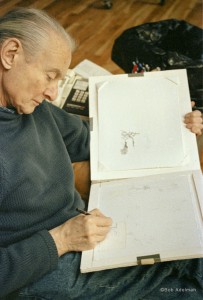
Roy Lichtenstein drawing in his Washington Street studio, ca. 1997.
© Bob Adelman
Works on a number of prints, including one for Leo Castelli’s 90th Birthday Portfolio (edition of 90) along with Cubist Cello (1997; edition of 75), which features references to Marc Chagall, in support of the Roy Lichtenstein Study Center for Contemporary Art at the Tel Aviv Museum of Art.
Embarks on a series of prints with Saff and Company that are meant to feature hand-painted brushstrokes; only one of the three prints (in an edition of 24) is completed by the artist before his death.
Sketchbooks evidence drawings after Cézanne’s Bather series.
Inspired by Leonardo da Vinci’s Last Supper (1495–98; Santa Maria delle Grazie, Milan, Italy) makes several colored-pencil drawings in sketchbooks for the murals at the Chapel of the Eucharist commission, but they are never realized.
Apr. 9 Dedication of the Roy Lichtenstein Study Center for Contemporary Art by the American Friends of the Tel Aviv Museum of Art, Israel.
Apr. 30 Interviewed by David Sylvester. The interview is one of the last given by the artist.
May Last major outdoor sculpture, comprising six large pieces, Singapore Brushstroke (1996; Millenia Pte Ltd.), is installed at the Pontiac Marina in Singapore.
June 15–Nov. 9 The 47th Venice Biennale opens. House II (1997; edition of 1), a composite construction with fiberglass of a house exterior, is shown at the Italian Pavilion in the exhibition Future, Present, Past, curated by Biennale commissioner Germano Celant.
Sept. 5–Oct. 7 Galerie Lawrence Rubin in Zurich presents an exhibition of new Interior paintings. Sylvester’s interview is published in the catalogue.
Sept. 29 Dies unexpectedly at New York University Medical Center in Manhattan from complications due to pneumonia.
Compiled by Clare Bell with subsequent additions and modifications by the Roy Lichtenstein Foundation and other scholars, post-March 2015 © Roy Lichtenstein Foundation.